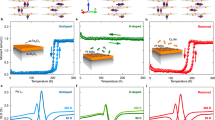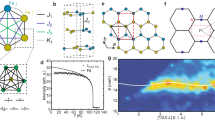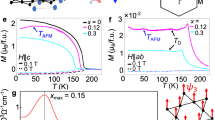Abstract
Antiferromagnetism is relevant to high-temperature (high-Tc) superconductivity because copper oxide and iron arsenide superconductors arise from electron- or hole-doping of their antiferromagnetic parent compounds1,2,3,4,5,6. There are two broad classes of explanation for antiferromagnetism: in the ‘local moment’ picture, appropriate for the insulating copper oxides1, antiferromagnetic interactions are well described by a Heisenberg Hamiltonian7,8; whereas in the ‘itinerant model’, suitable for metallic chromium, antiferromagnetic order arises from quasiparticle excitations of a nested Fermi surface9,10. There has been contradictory evidence regarding the microscopic origin of the antiferromagnetic order in iron arsenide materials5,6, with some favouring a localized picture11,12,13,14,15 and others supporting an itinerant point of view16,17,18,19,20. More importantly, there has not even been agreement about the simplest effective ground-state Hamiltonian necessary to describe the antiferromagnetic order21,22,23,24,25. Here, we use inelastic neutron scattering to map spin-wave excitations in CaFe2As2 (refs 26, 27), a parent compound of the iron arsenide family of superconductors. We find that the spin waves in the entire Brillouin zone can be described by an effective three-dimensional local-moment Heisenberg Hamiltonian, but the large in-plane anisotropy cannot. Therefore, magnetism in the parent compounds of iron arsenide superconductors is neither purely local nor purely itinerant, rather it is a complicated mix of the two.
This is a preview of subscription content, access via your institution
Access options
Subscribe to this journal
Receive 12 print issues and online access
$259.00 per year
only $21.58 per issue
Buy this article
- Purchase on SpringerLink
- Instant access to full article PDF
Prices may be subject to local taxes which are calculated during checkout




Similar content being viewed by others
References
Lee, P. A., Nagaosa, N. & Wen, X.-G. Doping a Mott insulator: Physics of high-temperature superconductivity. Rev. Mod. Phys. 78, 17–85 (2006).
Kamihara, Y., Watanabe, T., Hirano, M. & Hosono, H. Iron-based layered superconductor La[O1−xFx]FeAs (x=0.05–0.12) with Tc=26 K. J. Am. Chem. Soc. 130, 3296–3297 (2008).
Chen, X. H. et al. Superconductivity at 43 K in SmFeAsO1−xFx . Nature 453, 761–762 (2008).
Rotter, M., Tegel, M. & Johrendt, D. Superconductivity at 38 K in the iron arsenide Ba1−xKxFe2As2 . Phys. Rev. Lett. 101, 107006 (2008).
de la Cruz, C. et al. Magnetic order close to superconductivity in the iron-based layered LaO1−xFxFeAs systems. Nature 453, 899–902 (2008).
Zhao, J. et al. Structural and magnetic phase diagram of CeFeAsO1−xFx and its relation to high-temperature superconductivity. Nature Mater. 7, 953–959 (2008).
Hayden, S. M. et al. Comparison of the high-frequency magnetic fluctuations in insulating and superconducting La2−xSrxCuO4 . Phys. Rev. Lett. 76, 1344–1347 (1996).
Coldea, R. et al. Spin waves and electronic interactions in La2CuO4 . Phys. Rev. Lett. 86, 5377–5380 (2001).
Fawcett, E. Spin-density-wave antiferromagnetism in chromium. Rev. Mod. Phys. 60, 209–283 (1998).
Endoh, Y. & Böni, P. Magnetic excitations in metallic ferro- and antiferromagnets. J. Phys. Soc. Jpn 75, 111002 (2006).
Dai, J. H., Si, Q., Zhu, J. S. & Abrahams, E. Iron pnictides as a new setting for quantum criticality. Proc. Natl Acad. Sci. USA 106, 4118–4121 (2009).
Fang, C., Yao, H., Tsai, W. F., Hu, J. P. & Kivelson, S. A. Theory of electron nematic order in LaOFeAs. Phys. Rev. B 77, 224509 (2008).
Xu, C. K., Müller, M. & Sachdev, S. Ising and spin orders in iron-based superconductors. Phys. Rev. B 78, 020501(R) (2008).
Ma, F., Lu, Z. Y. & Xiang, T. Electronic structures of ternary iron arsenides AFe2As2 (A=Ba, Ca, or Sr). Preprint at <http://arxiv.org/abs/0806.3526> (2008).
Manousakis, E., Ren, J., Meng, S. & Kaxiras, E. Is the nature of magnetic order in copper-oxides and in iron-pnictides different? Preprint at <http://arxiv.org/abs/0902.3450> (2009).
Dong, J. et al. Competing orders and spin-density-wave instability in LaO1−xFxFeAs. Eur. Phys. Lett. 83, 27006 (2008).
Yildirim, T. Frustrated magnetic interactions, giant magneto-elastic coupling, and magnetic phonons in iron-pnictides. Physica C 469, 425–441 (2009).
Mazin, I. I. & Johannes, M. D. A key role for unusual spin dynamics in ferropnictides. Nature Phys. 5, 141–145 (2009).
Kariyado, T. & Ogata, M. Normal state spin dynamics of five-band model for ion-pnictides. J. Phys. Soc. Jpn 78, 043708 (2009).
Han, M. J., Yin, Q., Pickett, W. E. & Savrasov, S. Y. Anisotropy, itinerancy, and magnetic frustration in high-Tc iron pnictides. Phys. Rev. Lett. 102, 107003 (2009).
Zhao, J. et al. Low energy spin waves and magnetic interactions in SrFe2As2 . Phys. Rev. Lett. 101, 167203 (2008).
Ewings, R. A. et al. High-energy spin excitations in BaFe2As2 observed by inelastic neutron scattering. Phys. Rev. B 78, 220501(R) (2008).
McQueeney, R. J. et al. Anisotropic three-dimensional magnetism in CaFe2As2 . Phys. Rev. Lett. 101, 227205 (2008).
Matan, K., Morinaga, R., Iida, K. & Sato, T. J. Anisotropic itinerant magnetism and spin fluctuations in BaFe2As2: A neutron scattering study. Phys. Rev. B 79, 054526 (2009).
Diallo, S. O. et al. Itinerant magnetic excitations in antiferromagnetic CaFe2As2 . Phys. Rev. Lett. 102, 187206 (2009).
Wu, G. et al. Different resistivity response to spin density wave and superconductivity at 20 K in Ca1−xNaxFe2As2 . J. Phys. Condens. Matter 20, 422201 (2008).
Goldman, A. I. et al. Lattice and magnetic instabilities in CaFe2As2: A single-crystal neutron diffraction study. Phys. Rev. B 78, 100506(R) (2008).
Perring, T. G. et al. Spectacular doping dependence of interlayer exchange and other results on spin waves in bilayer manganites. Phys. Rev. Lett. 87, 217201 (2001).
Perring, T. G. et al. <http://tobyfit.isis.rl.ac.uk/Main_Page>.
Ye, F. et al. Spin waves throughout the Brillouin zone and magnetic exchange coupling in the ferromagnetic metallic manganites La1−xCaxMnO3 (x=0.25, 0.30). Phys. Rev. B 75, 144408 (2007).
Acknowledgements
We thank A. T. Boothroyd, T. Perring, D. Singh and A. Nevidomskyy for helpful discussions. This work is supported by the US National Science Foundation through DMR-0756568 and by the US Department of Energy, Division of Materials Science, Basic Energy Sciences, through DOE DE-FG02-05ER46202. This work is also supported in part by the US Department of Energy, Division of Scientific User Facilities, Basic Energy Sciences. The work at the Institute of Physics, Chinese Academy of Sciences, is supported by the Chinese Academy of Sciences. The work at USTC is supported by the Natural Science Foundation of China, the Chinese Academy of Sciences and the Ministry of Science and Technology of China.
Author information
Authors and Affiliations
Contributions
P.D. and J.Z. planned the experiment. X.F.W., G.W. and X.H.C. fabricated the samples. J.Z. and S.L. co-aligned the samples. J.Z., D.T.A., R.B. and P.D. carried out the neutron experiments and data analysis. D.-X.Y. and J.H. helped with data analysis. P.D. and J.Z. wrote the paper with input from other coauthors.
Corresponding author
Rights and permissions
About this article
Cite this article
Zhao, J., Adroja, D., Yao, DX. et al. Spin waves and magnetic exchange interactions in CaFe2As2. Nature Phys 5, 555–560 (2009). https://doi.org/10.1038/nphys1336
Received:
Accepted:
Published:
Issue date:
DOI: https://doi.org/10.1038/nphys1336
This article is cited by
-
Order from disorder phenomena in BaCoS2
Communications Physics (2024)
-
Thermal evolution of spin excitations in honeycomb Ising antiferromagnetic FePSe3
npj Quantum Materials (2024)
-
Long-lived spin waves in a metallic antiferromagnet
Nature Communications (2023)
-
Spin waves and phase transition on a magnetically frustrated square lattice with long-range interactions
Frontiers of Physics (2023)
-
Anisotropic magnon damping by zero-temperature quantum fluctuations in ferromagnetic CrGeTe3
Nature Communications (2022)



